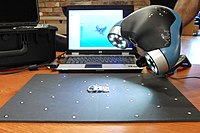
Photo from wikipedia
In this letter, a 24-GHz CMOS injection-locked frequency divider (ILFD) based on the push–push oscillator topology is designed and fabricated. It is further treated as the kernel component of a… Click to show full abstract
In this letter, a 24-GHz CMOS injection-locked frequency divider (ILFD) based on the push–push oscillator topology is designed and fabricated. It is further treated as the kernel component of a self-injection-locked (SIL) radar sensor for noncontact vital-sign detection. The push–push topology is employed to double the oscillation frequency of the 12-GHz LC oscillator to provide the 24-GHz transmitting signal of the radar sensor, while the direct injection-locked configuration is used to divide the receiving 24-GHz injection signal by 2. Hence, the 12-GHz output of the ILFD can be connected with a differentiator-based envelope detector for vital-sign demodulation. By packaging the developed ILFD chip and connecting it with two antennas, a gain block, a differentiator-based envelope detector, and a 24-GHz SIL radar sensor can be built to detect the physiological chest movement of a human subject. The feasibility of developing a SIL radar sensor in the millimeter-wave range is also demonstrated.
Journal Title: IEEE Microwave and Wireless Components Letters
Year Published: 2018
Link to full text (if available)
Share on Social Media: Sign Up to like & get
recommendations!